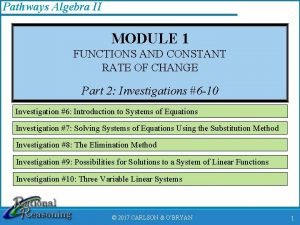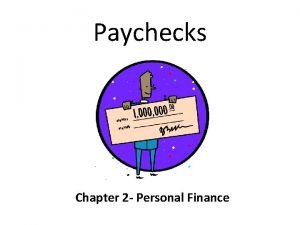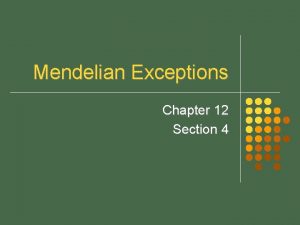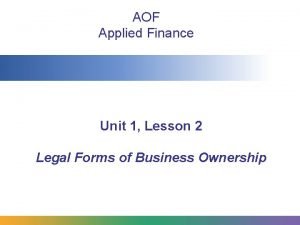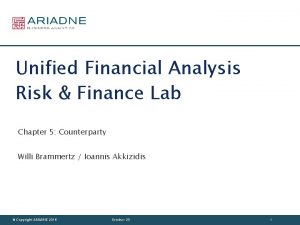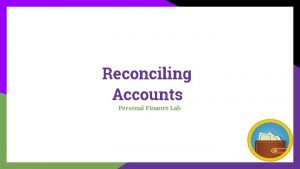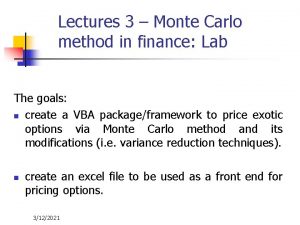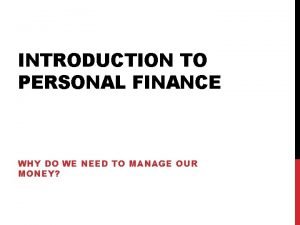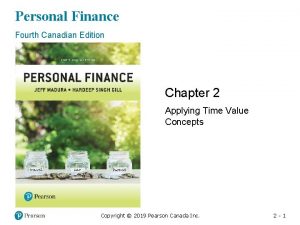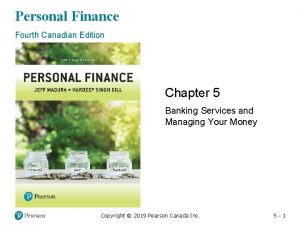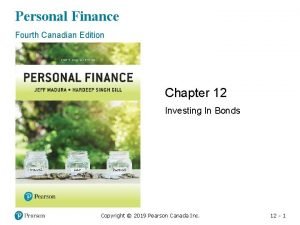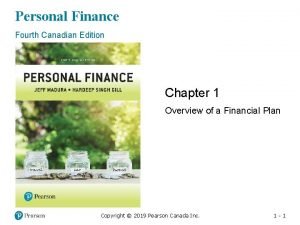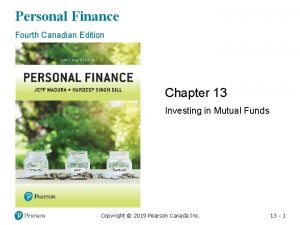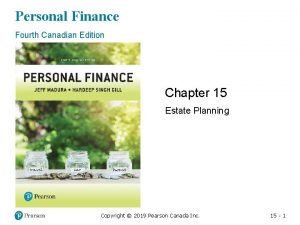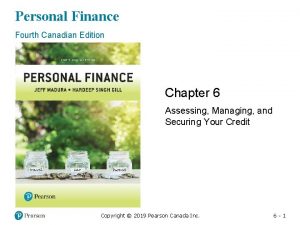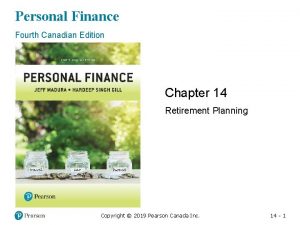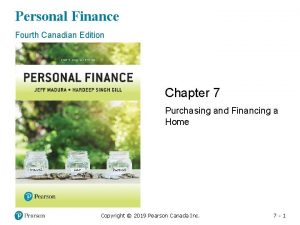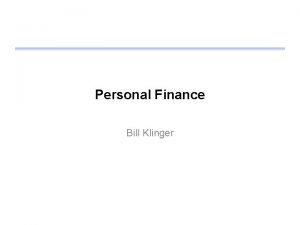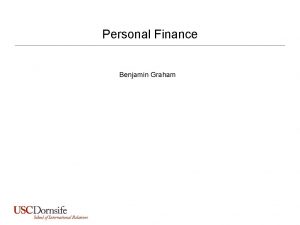Personal Finance Fourth Canadian Edition Chapter 2 Applying


















































- Slides: 50

Personal Finance Fourth Canadian Edition Chapter 2 Applying Time Value Concepts Copyright © 2019 Pearson Canada Inc. 2 -1

Chapter Objectives • Explain the difference between simple interest and compound interest • Calculate the future value of a single dollar amount that you save today • Calculate the present value of a single dollar amount that will be received in the future • Calculate the future value of an annuity • Calculate the present value of an annuity • Calculate the number of compounding periods and the nominal annual interest rate • Convert a nominal interest rate to an effective interest rate Copyright © 2019 Pearson Canada Inc. 2 -2

The Importance of the Time Value of Money • The gain or loss of interest on a dollar amount (when you spend money, you incur an opportunity cost of what you would have done with that money had you not spent it) • Interest: the rent charged for the use of money (you can pay or receive interest) • Two ways of computing interest: simple interest and compound interest Copyright © 2019 Pearson Canada Inc. 2 -3

Simple Interest • interest on a loan computed as a percentage of the loan amount, or principal – Interest earned, or paid (and is not reinvested) – Measured using the principal (P), the interest rate applied to the principal (r), and the loan’s time to maturity (t) Copyright © 2019 Pearson Canada Inc. 2 -4

Simple Interest Formula I=P×r×t where I = interest earned P = principal, or present value r = annual interest rate expressed as a decimal or percent t = time (in years) Copyright © 2019 Pearson Canada Inc. 2 -5

Simple Interest Example Farah makes a deposit of $1000 in a high-interest savings account paying 3 percent simple interest annually. At the end of year one, the bank will credit Farah’s chequing account with $30, calculated as: In year two, the initial principal of $1000 will again earn $30 in interest. The $30 will be credited to Farah’s chequing account. The table below displays what this process looks like over the first three years of Farah’s $1000 investment. Interest Accumulated Interest Amount Credited to Chequing Account Year Principal 1 $1000 $30 30 2 1000 30 60 30 3 1000 30 90 30 Copyright © 2019 Pearson Canada Inc. 2 -6

Compound Interest • the process of earning interest on interest • Ways to solve time value money (‘TVM’) problems: – TVM tables – TVM formulas – Financial calculator (e. g. TI BA II Plus) Copyright © 2019 Pearson Canada Inc. 2 -7

Compound Interest Example Samantha makes an initial deposit of $1000 in a compound interest savings account paying 3 percent interest annually. At the end of year one, the bank will credit Samantha’s account with $30 ($1000 × 0. 03 × 1). Compound interest increases the principal amount on which Samantha earns interest in the second year, by the amount of interest that is earned in the first year. In other words, in year two, she would earn 3 percent interest on the $1000 of original principal plus the $30 of interest earned in year one. This process will repeat itself in subsequent years. Year Principal Interest Accumulated Interest Account Balance 1 $1000. 00 $30. 00 $1030. 00 2 1030. 00 30. 90 60. 90 1060. 90 31. 83 92. 73 1092. 73 Copyright © 2019 Pearson Canada Inc. 2 -8

Lump Sums vs. Annuities • Time value of money is most commonly applied to two types of cash flows – a single dollar amount (a lump sum) and an annuity • Annuity: the payment of a series of equal cash flow payments at equal intervals of time Copyright © 2019 Pearson Canada Inc. 2 -9

Future Value of a Single Dollar Amount Formula Where FV = future value of an investment PV = present value of an investment i = annual interest rate (as a decimal or percent) n = number of compounding periods per year Free App: t = time (in years) Future Value of Your Money Copyright © 2019 Pearson Canada Inc. 2 - 10

Future Value of Single Dollar Amount Example One (formula) Based on her initial deposit of $1000, Samantha now asks you to determine how much money she would have in her compound interest savings account if she keeps it open for the next 20 years. Since it would be tedious and time consuming to create a table to calculate this amount, you have decided to use the future value formula for a single dollar amount. Using the formula above, you determine that she should have $1806. 11 in her account after 20 years. Copyright © 2019 Pearson Canada Inc. 2 - 11

Compounding Periods Table • The number of compounding periods per year for different compounding periods: Compounding Period Number of Compounding Periods per Year (n) Annually (every year) 1 Semi-annually (every 6 months) 2 Quarterly (every 3 months) 4 Monthly (every month) 12 Weekly (every week) 52 Daily (every day) 365 Copyright © 2019 Pearson Canada Inc. 2 - 12

Future Value of a Single Dollar Amount Table • Future Value Interest Factor (FVIF): a factor multiplied by today’s savings to determine how the savings will accumulate over time. – Depends on the interest rate and the number of years the money is invested • FVIF Table (see textbook) – Columns list an interest rate – Rows list a time period Copyright © 2019 Pearson Canada Inc. 2 - 13

Future Value of a Single Dollar Amount Example Two (table) Suppose that you want to know how much money you will have in five years if you invest $5000 now and earn an annual return of 9 percent. The present value of money (PV) is the amount invested, or $5000. The FVIF for an interest rate of 9 percent and a time period of five years is 1. 539 (look down the column for 9 percent, and across the row for five years). Thus, the future value (FV) of the $5000 in five years will be: Copyright © 2019 Pearson Canada Inc. 2 - 14

Using A Financial Calculator (1 of 2) • Basic TVM function keys are located in the 3 rd row of the TI BA II Plus keyboard • Important to clear the existing TVM values in the calculator’s TVM worksheet each time! • Enter a value for four of the five TVM keys (N, I/Y, PV, PMT, FV) • CPT= compute key, used after all values inputted Copyright © 2019 Pearson Canada Inc. 2 - 15

Using A Financial Calculator (2 of 2) • Cash outflows, such as an investment amount, are entered as a negative number • Cash inflows, such as investment income, are entered as a positive number • Specify the number of payments per year (P/Y) and the number of compounding periods per year (C/Y) (press 2 ND and the key- default is 1 payment/year)) Copyright © 2019 Pearson Canada Inc. 2 - 16

Using A Financial Calculator Example Copyright © 2019 Pearson Canada Inc. 2 - 17

Present Value of a Single Dollar Amount Formula • Discounting: the process of obtaining present values Copyright © 2019 Pearson Canada Inc. 2 - 18

Present Value of a Single Dollar Amount Example (formula) Suppose you want to know how much money you need to invest today to achieve $20 000 in three years, with 3% interest earned. (NOTE: n = 1) Copyright © 2019 Pearson Canada Inc. 2 - 19

Using the Present Value Table • Present Value Interest Factor (PVIF): a factor multiplied by the future value to determine the present value of that amount. – Depends on the interest rate and the number of years the money is invested • PVIF Table – Columns list an interest rate – Rows list a time period Copyright © 2019 Pearson Canada Inc. 2 - 20

Present Value of a Single Dollar Amount – Using a Financial Calculator Copyright © 2019 Pearson Canada Inc. 2 - 21

Two Types of Annuities • Ordinary annuity: a stream of equal payments that are received, or paid, at equal intervals in time, at the end of a period • Annuity due: a series of equal cash flow payments that occur at the beginning of each period **If the payment changes over time the payment stream does not reflect an annuity Copyright © 2019 Pearson Canada Inc. 2 - 22

Using Timelines • The best way to illustrate the future value of an ordinary annuity or an annuity due is through the use of timelines • Timelines: diagrams that show payments received or paid over time Copyright © 2019 Pearson Canada Inc. 2 - 23

Future Value of an Ordinary Annuity Example Timelines Copyright © 2019 Pearson Canada Inc. 2 - 24

Future Value of an Ordinary Annuity Formula • For an ordinary annuity, the future value can be determined using the formula: Copyright © 2019 Pearson Canada Inc. 2 - 25

Future Value of an Ordinary Annuity Example • Using the information from the timeline example: Copyright © 2019 Pearson Canada Inc. 2 - 26

Future Value of an Annuity Due Timeline The diagram above reflects the cash flows that would be paid from an annuity due. Copyright © 2019 Pearson Canada Inc. 2 - 27

Future Value of an Annuity Due Formula • For an annuity due, the future value can be determined by multiplying the future value of an annuity formula by (1+i) Copyright © 2019 Pearson Canada Inc. 2 - 28

Future Value of an Annuity Due Example • Referring again to the timeline example, the value of your investment if you invest at the beginning of the year is: Copyright © 2019 Pearson Canada Inc. 2 - 29

Using the Future Value Annuity Table • Future Value Interest Factor for an Annuity(FVIFA): a factor multiplied by the periodic savings level (annuity) to determine how the savings will accumulate over time. – Depends on the interest rate and the number of years the money is invested • FVIFA Table – Columns list an interest rate – Rows list a time period Copyright © 2019 Pearson Canada Inc. 2 - 30

Future Value of an Annuity Example Suppose that you have won the lottery and will receive $150 000 at the end of every year for the next 20 years. The payments represent an ordinary annuity and will be invested at your bank at an interest rate of 7 percent. Copyright © 2019 Pearson Canada Inc. 2 - 31

Future Value of an Annuity Solution (table) Example Copyright © 2019 Pearson Canada Inc. 2 - 32

Using A Financial Calculator for FV Copyright © 2019 Pearson Canada Inc. 2 - 33

Present Value of an Annuity • The present value of an annuity can be obtained by discounting the individual cash flows of the annuity and totaling them Copyright © 2019 Pearson Canada Inc. 2 - 34

Present Value of an Ordinary Annuity Timeline • Referring to our earlier example: Copyright © 2019 Pearson Canada Inc. 2 - 35

Present Value of an Ordinary Annuity Formula • The present value of an ordinary annuity can be determined using the formula: Copyright © 2019 Pearson Canada Inc. 2 - 36

Present Value of an Ordinary Annuity Example • Using the information from the timeline example: • If payments are at the beginning of each period i. e. an annuity due, you would multiply your answer by (1 + i) Copyright © 2019 Pearson Canada Inc. 2 - 37

Present Value of an Ordinary Annuity Table • Present Value Interest Factor for an Annuity (PVIFA): a factor multiplied by a periodic savings level (annuity) to determine the present value of the annuity. – Depends on the interest rate and the number of years the money is invested • PVIFA Table – Columns list an interest rate – Rows list a time period Copyright © 2019 Pearson Canada Inc. 2 - 38

PV of an Annuity Example You have just won the lottery. As a result of your luck, you will receive $82 000 at the end of every year for the next 25 years. A financial firm offers you a lump sum of $700 000 in return for these payments. If you can invest your money at an annual interest rate of 9 percent, should you accept the offer? Copyright © 2019 Pearson Canada Inc. 2 - 39

PV of an Annuity Solution (table) Example Copyright © 2019 Pearson Canada Inc. 2 - 40

PV of an Annuity Example Using a Financial Calculator Copyright © 2019 Pearson Canada Inc. 2 - 41

Using A Financial Calculator Solution Copyright © 2019 Pearson Canada Inc. 2 - 42

Calculate the Number of Compounding Periods (using calculator) Copyright © 2019 Pearson Canada Inc. 2 - 43

Calculate the Nominal Annual Interest Rate (using calculator) Copyright © 2019 Pearson Canada Inc. 2 - 44

Interest Rate Conversion (1 of 2) • Nominal interest rate: the stated or quoted, rate of interest – Also known as the annual percentage rate (APR) • When comparing two or more interest rates, the nominal interest rate is not useful because it does not take into account the effect of compounding Copyright © 2019 Pearson Canada Inc. 2 - 45

Interest Rate Conversion (2 of 2) • Effective interest rate: the actual rate of interest that you earn, or pay, over a period of time – Also known as the effective yield (EY) • Allows for the comparison of two or more interest rates because it reflects the effect of compound interest Copyright © 2019 Pearson Canada Inc. 2 - 46

Interest Rate Conversion Formula • Convert nominal interest rates to effective interest rates using the following formula: Copyright © 2019 Pearson Canada Inc. 2 - 47

Interest Rate Conversion Examples • Effective yield of 10 percent compounded semiannually is 10. 25%: • Effective yield of 10 percent compounded monthly is 10. 47%. . . Copyright © 2019 Pearson Canada Inc. 2 - 48

Interest Rate Conversion Table • Equivalent effective interest rates for various nominal interest rates: Nominal Interest Rate Effective Interest Rate 10% compounded annually 10. 00% 10% compounded semiannually 10. 25% 10% compounded quarterly 10. 38% 10% compounded monthly 10. 47% 10% compounded weekly 10. 51% 10% compounded daily 10. 52% Copyright © 2019 Pearson Canada Inc. 2 - 49

Effective Yield Using A Financial Calculator Copyright © 2019 Pearson Canada Inc. 2 - 50
 Sujata madan
Sujata madan Fundamentals of corporate finance third canadian edition
Fundamentals of corporate finance third canadian edition Personal finance 6th edition
Personal finance 6th edition Project 2 fourth edition
Project 2 fourth edition Pathways algebra 2 answer key
Pathways algebra 2 answer key Ethics in information technology fourth edition
Ethics in information technology fourth edition Ethics in information technology fourth edition
Ethics in information technology fourth edition Vertical line html
Vertical line html A computer programming team has 13 members
A computer programming team has 13 members Expert systems: principles and programming, fourth edition
Expert systems: principles and programming, fourth edition Marketing an introduction 6th canadian edition
Marketing an introduction 6th canadian edition Accounting principles second canadian edition
Accounting principles second canadian edition Accounting principles second canadian edition
Accounting principles second canadian edition Accounting principles second canadian edition
Accounting principles second canadian edition Accounting principles second canadian edition
Accounting principles second canadian edition Chapter 2 personal finance
Chapter 2 personal finance Foundations in personal finance chapter 1 review answers
Foundations in personal finance chapter 1 review answers Chapter 8 personal finance
Chapter 8 personal finance Chapter 4 post test personal finance
Chapter 4 post test personal finance Chapter 1 post test personal finance
Chapter 1 post test personal finance Overview of personal finance chapter 1
Overview of personal finance chapter 1 Corporate finance tenth edition
Corporate finance tenth edition Fundamentals of corporate finance fifth edition
Fundamentals of corporate finance fifth edition Corporate finance 6th edition
Corporate finance 6th edition Corporate finance tenth edition
Corporate finance tenth edition Corporate finance tenth edition
Corporate finance tenth edition Corporate finance tenth edition
Corporate finance tenth edition Corporate finance tenth edition
Corporate finance tenth edition Using mis 10th edition
Using mis 10th edition Using mis 10th edition
Using mis 10th edition Andalusian chicken incomplete dominance
Andalusian chicken incomplete dominance 11.2 applying mendel's principles
11.2 applying mendel's principles Chapter 12 lesson 2 applying mendels principles
Chapter 12 lesson 2 applying mendels principles Chapter 33 applying paints and enamels
Chapter 33 applying paints and enamels Chapter 12 lesson 2 applying mendels principles
Chapter 12 lesson 2 applying mendels principles Chapter 17 first aid
Chapter 17 first aid Cognitive learning theorist
Cognitive learning theorist Module 4 investing
Module 4 investing Personal finance gcse
Personal finance gcse Personal finance lab
Personal finance lab Business unit 3 personal and business finance
Business unit 3 personal and business finance Personalfinancelab
Personalfinancelab Personal finance unit 1 lesson 5
Personal finance unit 1 lesson 5 Personal finance lab
Personal finance lab Personal life cycle stages finance
Personal life cycle stages finance Personal finance lab
Personal finance lab Personal finance bell ringers
Personal finance bell ringers Personal finance assignment
Personal finance assignment Personal finance lab
Personal finance lab Introduction to personal finance
Introduction to personal finance Principles of business and finance unit 1 test
Principles of business and finance unit 1 test




